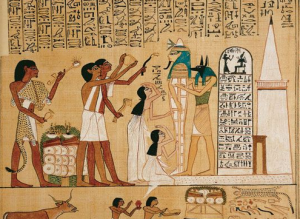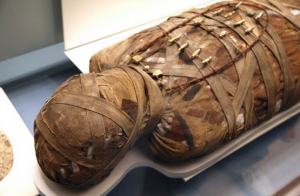Ancient Egyptian Mummies – History of How Ancient Egypt Buried their Dead
The ancient Egyptian people believed so much in the life after death and it was a crucial aspect of their culture. One famous way they prepared for the afterlife was by preserving the bodies of their deceased for as long as possible. Bodies were preserved via a process known as mummification. Further down on this page, you shall learn more on the history of ancient Egyptian mummies.
What is a Mummy?

Ancient Egyptian mummies
Before we delve into the history of Egyptian mummies, let us first of all, understand the meaning of a mummy. A mummy can be described as a dead human or creature whose skin and other organs have been conserved by means that involve either an accidental or intentional exposure to conditions that prevent the body from decaying. This practice usually involves exposing the body to chemicals, severe cold temperatures, or very low humidity. The practice is known as mummification.
Types of Mummies
There are generally two types of mummies: The Anthropogenic mummies and the spontaneous mummies. The former is a type of mummy that has been purposely created by living beings for either religious reasons or for any other reason. A spontaneous mummy, on the other hand, refers to mummies that have been accidentally created as a result of favorable environmental conditions.
Apart from the mummification of human bodies, ancient Egyptians also practiced the preservation of dead animals – usually cats. However, sacred Ibis were also commonly used when it came to animal mummification in ancient Egypt.
Prehistoric Mummification in Ancient Egypt
Prior to the days of anthropogenic mummification, bodies were naturally preserved by the earlier Egyptian burial methods. Regardless of the social status, ancient Egyptians buried their departed ones in shallow oval pit graves. This method of burial provided a natural environment for the mummification of their dead bodies. How? The extremely hot temperatures from the hot sand of the desert absorbed all the moisture in the body. This made the body less susceptible to decay. One of the oldest known naturally mummified bodies is that of the Gebelein Man also known as “Ginger”. The Gebelein Man‘s naturally mummified body was discovered in 1896 and dates to about 3500 BC.
The Beginning of Intentional Mummification in Ancient Egypt
With the passage of time, ancient Egyptians developed the practice of intentionally mummifying their dead bodies. This practice, which is deemed to have been inspired by anthropogenic mummification method is thought to have begun throughout the 4th and 5th dynasties (thus, about 2600 BC) in Ancient Egypt.
How were Bodies Mummified in Ancient Egypt (Steps in the Intentional Mummification Process)?

Ancient Egyptian mummification took several processes to ensure that bodies were properly preserved.
With the intentional mummification practice, the ancient Egyptians went through several intricate processes to ensure that the bodies of their dead were properly preserved for many years. The question is how did they achieve this in such ancient times? Well, the following step-by-step procedure, which took about 70 days were used by ancient Egyptians to conserve their dead bodies:
- Cleaning, washing, and purification of the body; They often used a mixture of several spices and also palm wine for the cleansing process.
- Removing parts of the brain via the nose area with a hook-shaped instrument. The brain was regarded as unimportant and therefore discarded.
- Making a cut at the left section of the abdomen area of the dead body. Internal organs which could easily cause decay were removed (evisceration) from the body via the cut section of the body. However, the heart was kept in the deceased’s body because early Egyptians supposed that it was the hub of intelligence and emotion. Therefore it was very necessary for the afterlife.
- Removed internal organs, for instance, the lungs, stomach, intestines, and liver were preserved by covering them with natron (salt with great drying properties) in order to remove all moisture in them. They were let to dry before being covered with linen and then stored in canopic jars.
- The body was also covered with natron and allowed to thoroughly dry for about 40 days. After which they were then cleaned and oiled.
- Sagging parts of the body were filled with linen and sawdust.
- Next, bodies were then wrapped with linen. Embalmers carefully wounded lengthy strips of linen all around the body. Priests placed amulets within the layers of linen, which were meant for the protection of the deceased’s person against evil. This process usually took up to 20 days.
- Bodies fully wrapped in linen were now placed in a large piece of cloth (shroud) and then tied with linen band. They were then covered with resin, so as to avoid moisture and humid air from getting in contact with the body.
- Finally, the fully bandaged body was now placed in a neatly designed wooden coffin or a mummy case (a case shaped to resemble the human body). Sometimes a sarcophagus (a stone coffin) was used.
- The coffin was then placed in a tomb (or grave). Other possessions (weapons, clothes, comb, food, and others) were included in a person’s tomb. The possession also included the Shabti dolls – which were supposed to assist in performing tasks assigned to the person in his or her afterlife. Usually, the number of Shabti dolls reflected the status (wealth) of the deceased person.
- The tomb was finally sealed (usually with a resin), however before being sealed, a ritual was performed. This ritual involved the priest invoking the goddesses Isis and Nephthys (those credited for bringing Osiris back to living).
Read more about Osiris in Birth, Death and Resurrection of Osiris, the Egyptian God of the Underworld
Why did Ancient Egyptians Care so much about their Dead Bodies?

Ancient Egyptians cared so much about their bodies.
The human body, in ancient Egypt religion, was seen as very crucial and was required for the proper functioning of a person’s soul. Ancient Egyptians believed that a person’s soul was made up of the several elements of which included: the “ka”, the “ba”, and the “akh”. It was believed that the soul required the presence of a person’s conserved body and a tomb in order to function in the afterlife. So you can see how important the body and its preservation (through mummification) were to the ancient Egyptian people.
Were all Ancient Egyptians Mummified in Similar Fashion?
Usually, the dead bodies of the pharaohs of Egypt and their royal lineage were mummified in an ostentatious manner. Some affluent people in the society, that is families that could afford the high cost of mummification, were also mummified flamboyantly. Generally, there were no restrictions, therefore anyone could be mummified.
However, the less affluent in the society could not afford the huge cost of mummifying their dead in a more elaborate way. Hence they resulted in cheaper and less elaborate means of mummification. This method of mummification for the less privileged involved covering the body with salt or resin and then the body was wrapped with few sheets of linen and few amulets. After which the body was deposited in a cave together with a small number of possessions.
When did Mummification End in Ancient Egypt?
It is estimated that over 70 million mummies were made during the era when mummification was practiced. The practice of mummifying the dead was abandoned during the fourth and the seventh century AD. This was mainly after the introduction of Christianity in Egypt.
Famous Egyptian Mummies
Most of the famous Egyptian mummies were of famous pharaohs and well-dignified people in ancient Egyptian society. Below are several notable mummies in Ancient Egypt:
Hatshepsut

Ancient Egyptian mummies | Hatshepsut
Hatshepsut was a pharaoh who was highly known for his outstanding success throughout ancient Egyptian history. She was the fifth pharaoh of the 18th dynasty.
Amenhotep I

Ancient Egyptian mummies | Amenhotep I
Amenhotep I reigned in the 18th Egyptian dynasty and he was the second pharaoh during that time. His leadership lasted between 1526 and 1506 BC. His mummified body was discovered at Deir el-Bahari, an Egyptian town.
Tutankhamun
Tutankhamun ruled between 1332 and 1323 BC as an early Egyptian pharaoh. He was famously known as King Tut. His tomb was unearthed in 1922. In the Egyptian museum, the mask of King Tut is a very popular one.
Ramesses I
Ramesses I was the first pharaoh of the 19th Egyptian dynasty. He reigned between 1292 and 1290 BC. His mummified remains were discovered in 1817.
Ramesses II

Popularly known as “Ramesses the great”, Ramesses II was a 19 dynasty pharaoh of Egypt. It is believed that Ramesses II was indeed a very great pharaoh and one of the most celebrated during the ancient times of Egypt. In 1881, the tomb of this great pharaoh was unearthed in the Valley of Kings in the Egyptian town Thebes. His time as pharaoh was between 1279 – 1213 BC.
Lady Rai

Ancient Egyptian mummies | Lady Rai
The mummified body of Lady Rai, who was Queen Ahmose-Nefertari’s nursemaid, was unearthed in 1881.
More:
- 10 Most Important Gods and Goddesses in Ancient Egypt
- Egyptian Pyramids: History and Interesting Facts
Some Facts about Egyptian Mummies
- Bodies were embalmed by special priests and they had detailed knowledge in the anatomy of the human body.
- Mummification was an expensive practice.
- Mummification of a body actually took about 70 days to complete.
- The god Anubis was the god of mummification and he was perceived to possess the head of a jackal.
- During mummification processes, priests wore the mask of a jackal. This was done in honor of Anubis.
- Unwrapped mummies weigh only about 5 pounds.
Conclusion
The mummification process was a great way of preserving the body of a dead person for as long as possible. In ancient Egypt, this practice was an essential aspect of their culture, beliefs, and burial traditions.



























